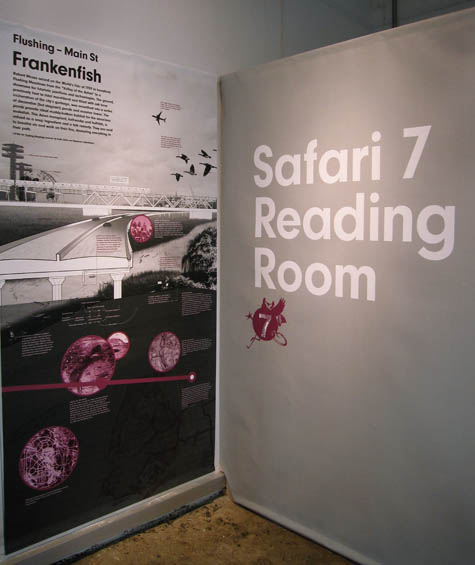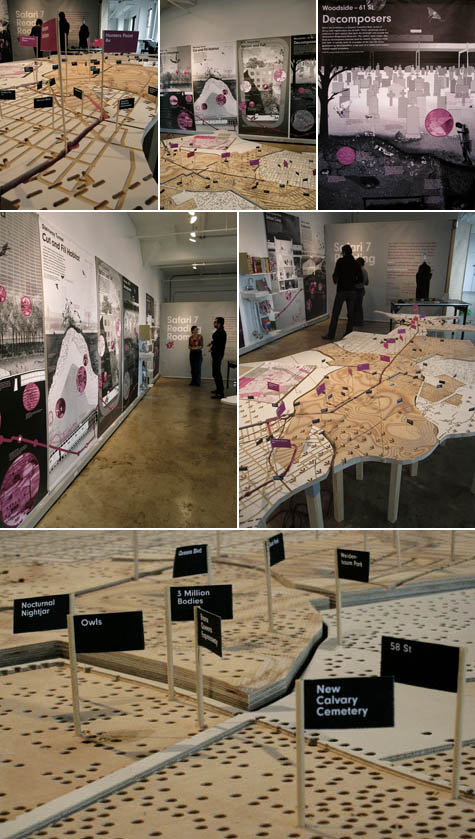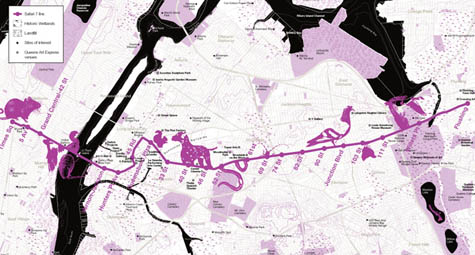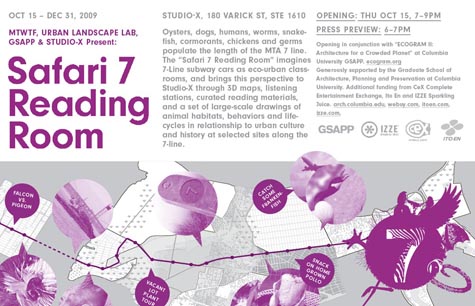Safari 7
 [Image: The Safari 7 Reading Room open now at Studio-X].
[Image: The Safari 7 Reading Room open now at Studio-X].Earlier this year, while driving down Highway 5, from San Francisco to Los Angeles, my wife and I passed through huge and endless clouds of butterflies. For a few seconds, the effect was extraordinarily beautiful—even sublime—but, within an instant, our car was covered in tiny corpses: yellow blurs smashing repeatedly against the windshield, leaving a grotesque series of impenetrable smudges. Looking at the other cars around us—not to mention heavy moving trucks and agricultural semis running short-haul routes downstate—it was clear that an all-out slaughter of these migratory butterflies was underway.
What strange irony of the California landscape would lead butterflies to follow a major highway on their seasonal migrations—or what triumph of bad planning would result in that highway being built in perfect alignment with a preexisting animal geography?
Of course, the landscape itself might all but guarantee such an overlap, as California's central valley offers both Caltrans and Painted Lady butterflies an effective and easy route to from north to south. But what other examples might there be of human transportation infrastructure coexisting with biological routes of passage?
 [Images: Gavin Browning of Studio-X shows Nicola Twilley of Edible Geography around the Safari 7 Reading Room].
[Images: Gavin Browning of Studio-X shows Nicola Twilley of Edible Geography around the Safari 7 Reading Room].I'm reminded here of artist Elliot Malkin's Graffiti for Butterflies project, which—morally or not—sought to create new migration routes for other species using aerosol sprays that only non-human eyes can see.
What paths for animals could we thus build through our cities? Birds following WiFi signals along parallel geographies through the urban canyons our buildings now frame...
Exploring all of these questions, and more, is a cool new exhibition called the Safari 7 Reading Room, which opened last night at New York's Studio-X. Nicola Twilley, of Edible Geography, and I got to take a tour of the exhibition before it opened with Studio-X's Gavin Browning.
 [Image: A map of the 7 train's ecological route; from the Safari 7 Reading Room].
[Image: A map of the 7 train's ecological route; from the Safari 7 Reading Room].The project, developed by Urban Landscape Lab and MTWTF, with a series of podcasts created by architecture students from Barnard & Columbia Colleges, treats New York City's 7 train as a kind of safari: what creatures live along the 7 line—and what ecosystem does the train route explore?
- Oysters, dogs, humans, worms, snakefish, cormorants and germs are some of the species that populate the length of the MTA 7 train. The “Safari 7 Reading Room” is an exhibition that presents a series of 3D maps, audio listening stations, curated reading materials, and a series of large-scale drawings of animal habitats, behaviors and life cycles in relationship to urban culture and history at selected sites along the MTA No. 7 line.
 [Image: Let's go on a city safari... From Safari 7].
[Image: Let's go on a city safari... From Safari 7].The city is treated as an environment full of "decomposers" (the 7 line passes by graveyards), "urban coops" (there are gardens and allotments along the way), "Frankenfish" (aquatic life mutationally altered by chemical runoff), dog parks, weed-choked vacant buildings, and more.
It's a nature tour of New York, using the city's existing transportation infrastructure as both route and guide—and it's a fantastic idea.
 Vaguely similar things have been done, for instance, in London, where walking tours of the now-buried rivers beneath the city's surface reveal what present-day geographies inhabit these lost natural worlds today. Of course, there is also Fritz Haeg's Animal Estates project, which asks us "to consider the animals that we share our cities with, and creates dwellings for animals that have been unwelcome or displaced by humans. As animal habitats dwindle daily," Haeg continues, "Animal Estates proposes the reintroduction of animals back into our cities, strip malls, garages, office parks, freeways, front yards, parking lots, skyscrapers, and neighborhoods."
Vaguely similar things have been done, for instance, in London, where walking tours of the now-buried rivers beneath the city's surface reveal what present-day geographies inhabit these lost natural worlds today. Of course, there is also Fritz Haeg's Animal Estates project, which asks us "to consider the animals that we share our cities with, and creates dwellings for animals that have been unwelcome or displaced by humans. As animal habitats dwindle daily," Haeg continues, "Animal Estates proposes the reintroduction of animals back into our cities, strip malls, garages, office parks, freeways, front yards, parking lots, skyscrapers, and neighborhoods." Further, I remember reading in Alan Weisman's book The World Without Us that many of New York's subway lines would simply become "rivers" after mere weeks of pumpless-ness (it would only take 36 hours, I believe Weisman wrote, for the entire New York subway system to flood should the pumps truly fail).
This notion that much older ecologies and whole parallel geographies lie waiting beneath our cities, just waiting to self-resurrect and come roaring back to the surface, is something that has long fascinated me. Along these lines, there's a great quotation from Michael Novacek's book Terra:
- Ecologists often point out that the images of Earth still harboring unspoiled, pristine wild places is a myth. We live in a human-dominated world, they say, and virtually no habitat is untouched by our presence. Yet we are hardly the infallible masters of that universe. Instead, we are rather uneasy regents, a fragile and dysfunctional royal family holding back a revolution.
In any case, I'd be remiss if I didn't mention one more project in this context: Invisible-5, an eco-geo-socio-enviro-chemical audio tour of California's Highway 5, the same route where this post began:
- Invisible-5 investigates the stories of people and communities fighting for environmental justice along the I-5 corridor, through oral histories, field recordings, found sound, recorded music, and archival audio documents. The project also traces natural, social, and economic histories along the route.
The Safari 7 Reading Room is up at Studio-X until December 31, 2009.





Comments are moderated.
If it's not spam, it will appear here shortly!
Interesting! That quote from Michael Novacek reminded me of resistentialism, and Russell Baker's funny (with an element of truth) saying: "The goal of all inanimate objects is to resist man and ultimately defeat him." Thank you for making all these connections between events and ideas.
Excellent article! As a New Yorker, I thank you so much for mentioning the Safari 7 Reading Room. The more information and awareness, the more inclined we are to become the change that we need. The world does not belong to us, we share the planet with millions of species, therefore, it is our responsibility to reduce our impact on the earth. Thank you again ~!
This comment has been removed by the author.
NPR did a profile today of a town in Montana with a river running under its Main Street: http://www.npr.org/templates/story/story.php?storyId=113889332&ps=cprs
Also just remembered a good article about underground rivers in Dot Earth: http://dotearth.blogs.nytimes.com/2009/07/15/a-river-runs-under-it
Hmmm, maybe funny isn't the right word for the Russell Baker quote. More like facetious. Anyway, it's great to find out about projects that focus on how we relate with the nonhuman world.
The shop I am currently in worked on the redesign of a 56 mile long stretch of highway in order to allow coexistence with the ecological topography of the region. Not only was the goal to allow coexistence, but also developing a roadway that heals both the natural landscape and by extension the cultural landscape of the Confederated Salish and Kootenai Tribes, and the rural communities that lived along the corridor.
Here is the official MDT link
http://www.mdt.mt.gov/pubinvolve/us93info/
and here is a project summary from our office
http://www.jonesandjones.com/work/regions.html#p7GPc1_3
http://www.jonesandjones.com/images/regions/flathead/1-US-93-Through-Flathead-Reservation.jpg
Post a Comment